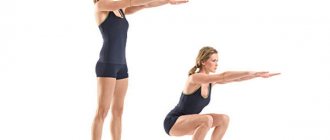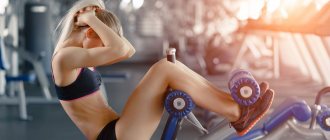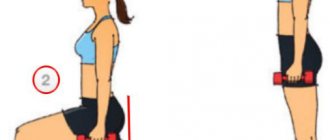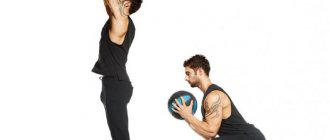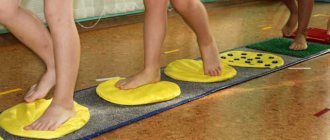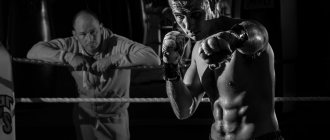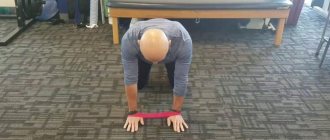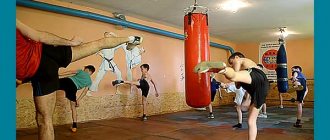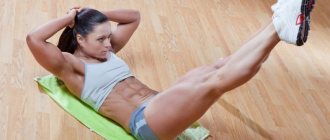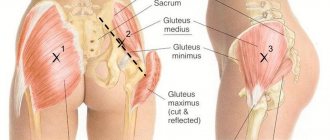After knee surgery (arthroscopy), the muscle that weakens the most is the quadriceps. These exercises will return her functional ability (turn on) and also restore the mobility of the remaining thigh muscles.
Clothes should be loose, it is advisable to remove shoes. Perform all exercises (especially the first days) smoothly and gradually. Remember the important principle: “Endure mild pain, do not allow severe pain.”
Try to do these exercises daily for at least 2 weeks.
Lying knee bend
Lying on your stomach, legs straight. Bend the knee of the leg you are working on, trying to touch your buttock with your heel. Hold for 5 seconds, then relax and return your leg to the starting position. 2 sets of 15 reps.
Strengthening exercises
You can start doing strengthening exercises only when the pain when walking up the stairs has completely gone away. Usually this is 1 week after the start of rehabilitation.
Features of working with quadriceps
Correct technique plays a huge role in the work of the quadriceps. The health and condition of the knees and lower back depends on it. By sinning with the technique of performing exercises, the athlete transfers the main load to other muscle groups.
Like all large muscles, the quadriceps muscle takes a long time to recover. In most cases, there is no point in training it more than once a week . An option with two leg workouts is allowed, but then they are separated: the first one works the quadriceps, the second one works the back of the thigh.
The basis of the training program should be basic (multi-joint) exercises. They are designed for mass and strength, as they load the legs and body in a complex manner. Isolated movements help to detail the muscles, give them a “cut,” and can also be used to warm up before heavy compound exercises.
For this reason, in the first few years of systematic training, you need to focus on the “base”. And only then, having gained mass and strength, you can start polishing your legs. This doesn't mean that beginners should ignore single-joint movements. They are also needed, but priority is given to the basic ones. This also applies to women seeking to lose weight and have a striking silhouette. Basic movements performed in a high-repetition style are the main secret to success.
Wall Squats
Stand with your back to the wall, looking straight ahead. Feet shoulder-width apart and at a distance of 40-50 cm from the wall. Squat down slowly until your thighs are almost parallel to the floor. Hold this position for 10 seconds. Smoothly return to the starting position. 2 sets of 15 reps. Gradually increase the hold time to better strengthen the quadriceps muscle.
Quadriceps exercises
There are hundreds of leg exercises. There is no point in listing everything: those described in the article are more than enough. Moreover, most movements are variations of the basic ones.
Basic
This section describes the main exercises for the quadriceps. Beginners often try to stay away from them, but without a “base” they are nowhere.
Squats
The main and most “scary” exercise for beginners. Barbell squats work most of the muscles in the body—the legs, buttocks, back, and abs. Even the arms and shoulders can be used - without strong ligaments in the arms it is difficult to hold a heavy barbell.
At the very beginning, focus on execution technique. Squatting incorrectly can cause problems with your knees, lower back and neck. To put more stress on the quadriceps, train with relatively light weights. By going too far with the plates, the athlete will not be able to avoid the powerful engagement of the buttocks and back.
Squat pattern:
- Starting position (IP) – the bar lies on the trapezius (in no case on the neck), hands hold the bar with a narrow grip (as far as flexibility allows), chest forward, back straight. It is strictly forbidden to hunch over during the entire movement. Feet stand shoulder-width apart, toes slightly pointed to the sides. To get into IP, you need to sit under the bar lying on the racks, remove it and step back.
- You need to start a squat by moving your pelvis back. The knees are in line with the feet - you cannot turn your knees inward. Also try not to bring them forward with your feet.
- Lower yourself to a position where your thighs are parallel to the floor. By undersquatting, you don't do enough work; by squatting deeper, you take the load off your quadriceps and put more stress on your gluteal muscles.
- Smoothly but powerfully, as you exhale, return to IP. The knees should remain slightly bent at the top - this is a prerequisite for reducing the risk of injury from the exercise.
The position of the legs can and should be varied - from narrow to a position slightly wider than the shoulders. If the position is too wide, the biceps of the thigh are more loaded. When squatting, your feet do not leave the floor. When performing the movement, look in front of you or slightly up. This helps keep your back straight and focused on the exercise.
At home, the barbell can be replaced with dumbbells. In this case, the hands with the shells are lowered down.
Front squats with barbell
Front squats are a similar exercise in which the barbell is placed in front rather than behind. Thanks to this, the load on the quadriceps becomes more targeted - the buttocks are used much less.
Technique:
- Approach the bar lying on the racks and fix it on the front delts. The hands are placed crosswise, helping to hold the barbell - this is IP.
- Keeping your back absolutely straight, squat down to parallel.
- Return to IP.
© Makatserchyk — stock.adobe.com
In this exercise, keeping your back straight is more difficult, so you need to not overdo it with the weight of the projectile.
The position of the hands may be different. Trained lifters often secure the bar with their hands positioned in the style of a weightlifter performing a clean and jerk. To do this you need to have a certain flexibility, strong ligaments and a powerful grip.
Leg press
The leg press eliminates the work of the back and buttocks as much as possible. At the same time, the simulator makes it possible to work with much more weight than in squats. To place the load on the quadriceps, you need to press with your feet shoulder-width apart.
Technique:
- IP - the back and head are tightly pressed to the back of the simulator, the legs are almost completely straightened and rest against the bed, the hands firmly hold the handles.
- Bend your knees until a right angle is formed between your thighs and shins.
- Return your legs to IP.
At the top point, the knees must be slightly bent. This is especially important with leg presses, since full extension can result in very serious injury.
A variation of this exercise is the single leg press. In this case, the weight is taken significantly less.
© bennymarty — stock.adobe.com
Hack squats
Since the back in this exercise is also pressed tightly against the back of the machine, the main load is placed on the quadriceps muscles of the legs. The exercise is an inverted press - it is not the feet that go up, but the body.
Execution scheme:
- IP - standing on the platform, feet positioned shoulder-width apart, body straight, shoulders resting on the pillows, hands holding the handles.
- Lower yourself down to parallel, feeling the tension in your quadriceps.
- Return to IP.
© splitov27 — stock.adobe.com
You cannot round your back, lift your toes or heels off the platform, and completely straighten your knees at the top.
Lunges with barbell and dumbbells
Lunges can be done in different ways - with a barbell, in a Smith machine, with dumbbells, walking around the gym and standing still. Let's consider options in which the athlete stands in one place, using either a barbell or dumbbells.
Technique for working with the bar:
- The IP is similar to the position for back squats.
- Step forward with your right foot. The lunge should be such that the thigh of the working leg at the lowest point is parallel to the floor. The knee of the left leg almost touches the floor and also forms a right angle.
- Return to IP.
- Switch legs and lunge with your left leg.
© Makatserchyk — stock.adobe.com
Do the same exercise with dumbbells. In this case, the hands with the projectiles are lowered along the body:
© Makatserchyk — stock.adobe.com
The disadvantage of this option is that it does not always allow you to work with a suitable weight. The grip is weaker than the legs, so training with a barbell is preferable. But for women who carry light weights, dumbbells are a good option. Men who use wrist straps or have a strong grip will also appreciate this option.
Single leg squats
Can't go to the gym? Squat on one leg. This is a great quadriceps exercise that can work your legs without even using additional weights. True, you shouldn’t expect a significant increase in mass or strength from him.
Scheme:
- IP – standing, “non-working” leg slightly extended forward.
- Squat down to parallel, extending your other leg so as to form a “pistol” (another name for this exercise).
- Return to IP.
© Makatserchyk — stock.adobe.com
Unlike regular squats, this variation does not require keeping your back straight. A slight rounding is normal. It is important to stand up using the force of the quadriceps, minimizing the involvement of the buttocks.
Isolated exercises
These movements will not make the legs more massive, but they will bring to mind what has been developed as a “base”.
Leg extensions in the simulator
This exercise draws out the front of the thigh. Suitable for warming up before a heavy squat (15-20 repetitions with a light weight without failure), and for “finishing up” at the end of a leg workout.
Technique:
- IP - sitting in the simulator, the lower back is pressed against the back, the legs are bent at the knees, the feet are fixed with bolsters, the hands hold the handles tightly.
- Straighten your legs at the knee joints.
- Pause for a moment at the top, tensing your quadriceps as much as possible, then return your legs to the IP position.
© Makatserchyk — stock.adobe.com
Do the exercise until your muscles burn. The movements are smooth and slow; if you are negative, you should not “throw” your legs down, lower them under control.
Anatomical features of the quadriceps femoris muscle
The quadriceps femoris muscle is located on the front of the thigh. It is attached to the tibia through the patella ligament. In accordance with the name, it consists of 4 muscle bundles:
- rectus muscle;
- intermediate;
- lateral (outer);
- medial (internal).
The structure of the quadriceps femoris muscle.
The quadriceps is a large and strong muscle group. They are the main extensors of the knee joint and perform the following main functions:
- static (prevents bending of the knee joint in a standing position);
- dynamic (provides stability of the knee joints during movement).
Video covers quadriceps anatomy, exercises and stretches
The anatomy of the quadriceps involves the presence of slow and fast muscle fibers. Slow ones are responsible for the static function. Fast fibers provide elasticity.
Important! To achieve the desired results, you need to know what your ratio of slow-twitch fibers to fast-twitch fibers is. The nature and intensity of the exercises depends on this.
Readers found these materials useful:
- Exercises for calf muscles at home
- Effective leg training for weight in the gym
Pumping up the Quadriceps - Video
While improving their physical fitness, many may have noticed that even with heavy loads, the inner thighs remain insufficiently toned.
The solution to this problem will be special training, during which attention is concentrated specifically on this zone. Therefore, today we offer you an overview of the Top 7 most effective exercises for the inner thigh. There are many exercises that use your legs. However, not all of them “specialize” in restoring tone to the thigh muscles. At the same time, there are several very successful and effective exercises that help eliminate sagging and reduce the volume of the problem area for many women and men. We will talk about them further.
Exercises for health problems
Not all sports are safe and allow you to control your body every second to avoid injury. For example, team sports, especially contact sports: hockey, football, rugby. Yes, this also happens in fitness, but, as a rule, due to violation of the basic rules of training!
Having damaged the knee joint, people are forced to give up their usual loads and undergo a rehabilitation course. And if the injury was serious, then undergo surgical treatment, and then engage in the already mentioned rehabilitation.
To speed up the postoperative recovery process, a surgical procedure with minimal tissue trauma - arthroscopy - is often performed. After it, the patient can perform physical therapy the very next day. Then the patient is discharged, and further rehabilitation actions fall on his shoulders.
And this is where the main thing is not to harm yourself! It is necessary to return to training gradually, dividing the entire recovery phase into several parts.
Stage No. 1
As a rule, it can be done at home, but it is better to contact experienced rehabilitators! The goal of the stage is to return the joint to its usual mobility.
The exercises are performed slowly, without weights, and often while sitting or lying down. The stage can be considered complete when joint mobility is restored by more than 60%.
Stage No. 2
Here the emphasis is on strengthening muscles and ligaments that may have been significantly weakened after injury and surgery. The exercises can still be done at home, but with light weights. You can use rubber bands or tubular expanders as weights.
Exercises for two stages are presented in the video.
Bulgarian lunges
An isolating exercise, due to consistent loading, has a visible tightening effect on the quadriceps area, without pumping or overstraining it. The difficulty is high, due to the fact that in addition to performing lunges, it is necessary to concentrate attention and maintain balance . Additionally, lunges will load the buttocks and back of the thighs.
Technique:
- Starting position – the left leg rests on the support, the right leg is relaxed, put forward;
- As you inhale, lunge with emphasis on your right limb until your knee forms a 90-degree angle. The load in the foot is shifted to the heel;
- As you exhale, we return to the starting position.
More details in the video:
For good results, you need to implement 15-18 lunges on each leg in 2-3 sets with a break of a minute.
